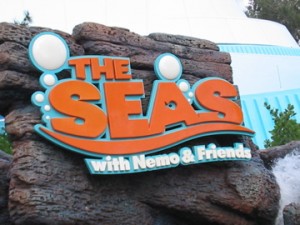 I understand there are a lot of families who skip The Seas With Nemo and Friends when they visit Epcot. The Finding Nemo-based ride through the oceans in a clammobile isn’t for everyone – I get that. Turtle Talk with Crush is targeted at preschoolers and the general consensus seems to be that once the kids are a little older, there are more exciting things to see and do at Epcot. I’m sad for the families who haven’t given The Seas pavilion another try. There are some pretty amazing things to be found there and a couple of them are manatees.
I understand there are a lot of families who skip The Seas With Nemo and Friends when they visit Epcot. The Finding Nemo-based ride through the oceans in a clammobile isn’t for everyone – I get that. Turtle Talk with Crush is targeted at preschoolers and the general consensus seems to be that once the kids are a little older, there are more exciting things to see and do at Epcot. I’m sad for the families who haven’t given The Seas pavilion another try. There are some pretty amazing things to be found there and a couple of them are manatees.
I’m surprised by how many visitors completely miss Epcot’s manatees in The Seas with Nemo and Friends. They’re pretty gigantic and absolutely amazing to watch – especially if you happen to time your visit around the manatees’ feeding schedule. There are two viewing areas – upstairs (at the tank’s surface) Cast Members feed the manatees and make manatee presentations (check the schedule). Downstairs is the underwater viewing area.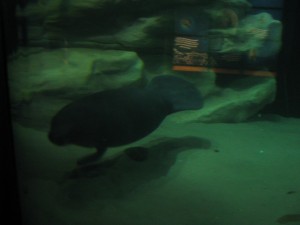
Slow moving gentle giants, manatees are animals known as Sirenians – this group of aquatic mammals (related to elephants) can be found in many places around the world. A subspecies of the West Indian manatees are the ones we can find in Florida. There are also West African and Amazonian manatees and a close manatee relative called the Dugong (found in warm coastal waters from East Africa to Australia).
A quick peek over at Save The Manatee.org revealed some other interesting manatee tidbits:
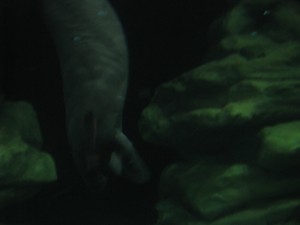 Manatees are large and gray. They have two flippers and a paddle-shaped tail. Flippers have 3-4 nails on each.
Manatees are large and gray. They have two flippers and a paddle-shaped tail. Flippers have 3-4 nails on each.- Adult manatees reach about 10-feet in length and weigh 800-1200 lbs.
- Manatees normally surface every 3-5 minutes to breathe, but can remain underwater for up to 20 minutes when resting.
- Manatees spend most of their time eating (plants), resting, and traveling.
- The reproduction rate for manatees is low. Females produce a calf only once every 2-5 years.
- Florida manatees are believed to normally live 60 years or more, but are currently an endangered species – recent studies predict the manatee population in Florida to be less than 5000 animals.
“Most human-related manatee fatalities occur from collisions with watercraft. Other causes of 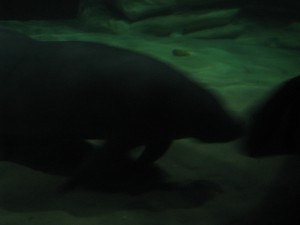 human-related manatee mortality include being crushed and/or drowned in canal locks and flood control structures; ingestion of fish hooks, litter, and monofilament line; and entanglement in crab trap lines. Ultimately, loss of habitat is the most serious threat facing manatees in the United States today.” – Save the Manatee.org
human-related manatee mortality include being crushed and/or drowned in canal locks and flood control structures; ingestion of fish hooks, litter, and monofilament line; and entanglement in crab trap lines. Ultimately, loss of habitat is the most serious threat facing manatees in the United States today.” – Save the Manatee.org
Last time I visited Epcot, there were two manatees (Lou and Vail) who had both been victims of boat strikes in the wild – both were missing large sections of their tails. The last news I’d heard about the pair was that, sadly, Vail had passed away last October (2013) and a new manatee had joined Lou named Lil’ Joe. Lil’ Joe had been orphaned young and mostly raised in captivity. I’m planning to stop by and see Lou and Lil’ Joe in a couple of weeks – if there’s any news, I’ll post an update. Over the years, Epcot has rehabilitated sick and injured manatees who were able to be reintroduced into the wild.
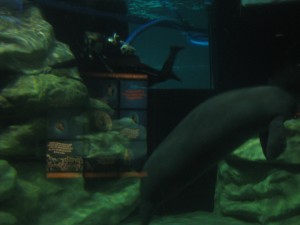 So, to end my manatee monologue, I’ll say this: Go see them! What a wonderful opportunity to teach every member of the family about animal conservation – right there in Epcot! Not into educational opportunities while on vacation? The manatees are still some of the coolest animals you’ll ever see!
So, to end my manatee monologue, I’ll say this: Go see them! What a wonderful opportunity to teach every member of the family about animal conservation – right there in Epcot! Not into educational opportunities while on vacation? The manatees are still some of the coolest animals you’ll ever see!
When you go to Walt Disney World, do you take the time to visit the manatees?
